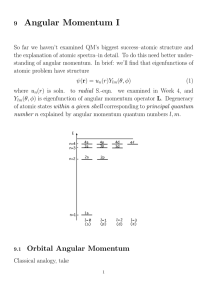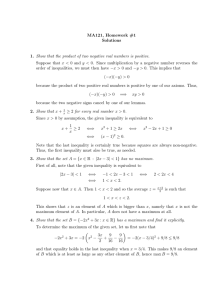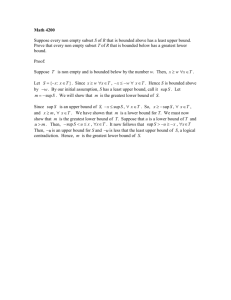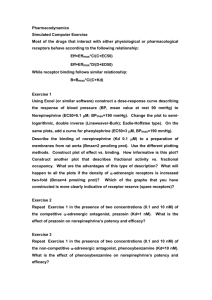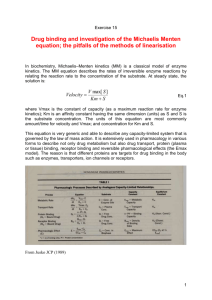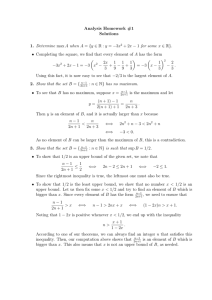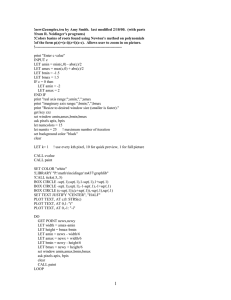Document 10677159
advertisement
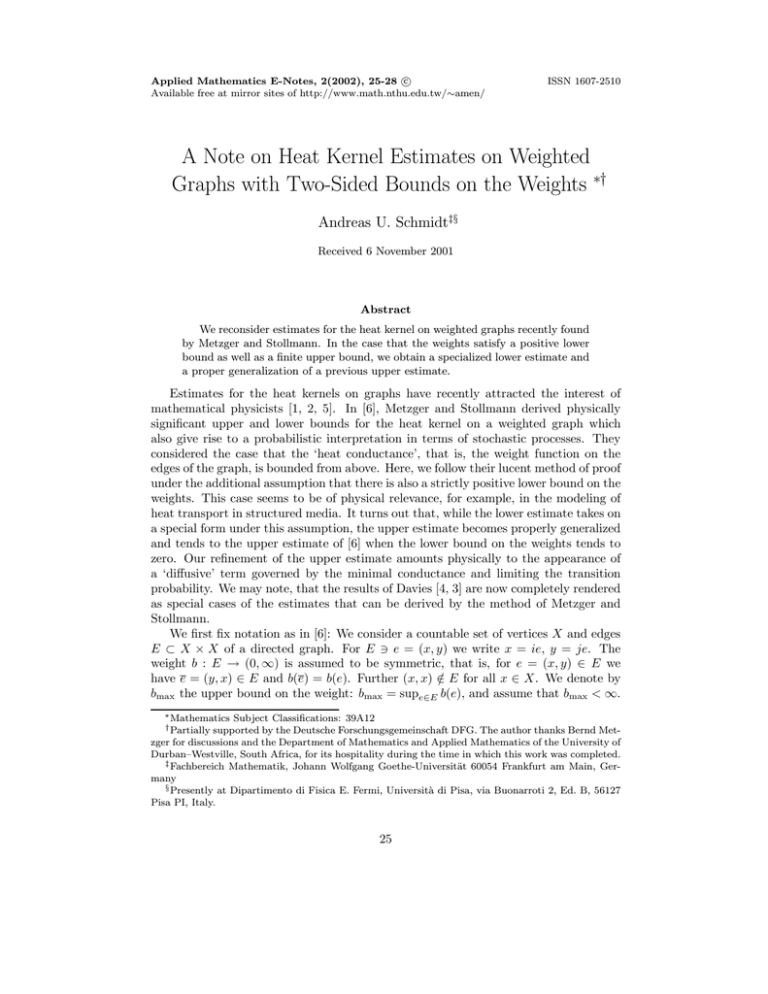
Applied Mathematics E-Notes, 2(2002), 25-28 c
Available free at mirror sites of http://www.math.nthu.edu.tw/∼amen/
ISSN 1607-2510
A Note on Heat Kernel Estimates on Weighted
Graphs with Two-Sided Bounds on the Weights ∗†
Andreas U. Schmidt‡§
Received 6 November 2001
Abstract
We reconsider estimates for the heat kernel on weighted graphs recently found
by Metzger and Stollmann. In the case that the weights satisfy a positive lower
bound as well as a finite upper bound, we obtain a specialized lower estimate and
a proper generalization of a previous upper estimate.
Estimates for the heat kernels on graphs have recently attracted the interest of
mathematical physicists [1, 2, 5]. In [6], Metzger and Stollmann derived physically
significant upper and lower bounds for the heat kernel on a weighted graph which
also give rise to a probabilistic interpretation in terms of stochastic processes. They
considered the case that the ‘heat conductance’, that is, the weight function on the
edges of the graph, is bounded from above. Here, we follow their lucent method of proof
under the additional assumption that there is also a strictly positive lower bound on the
weights. This case seems to be of physical relevance, for example, in the modeling of
heat transport in structured media. It turns out that, while the lower estimate takes on
a special form under this assumption, the upper estimate becomes properly generalized
and tends to the upper estimate of [6] when the lower bound on the weights tends to
zero. Our refinement of the upper estimate amounts physically to the appearance of
a ‘diffusive’ term governed by the minimal conductance and limiting the transition
probability. We may note, that the results of Davies [4, 3] are now completely rendered
as special cases of the estimates that can be derived by the method of Metzger and
Stollmann.
We first fix notation as in [6]: We consider a countable set of vertices X and edges
E ⊂ X × X of a directed graph. For E e = (x, y) we write x = ie, y = je. The
weight b : E → (0, ∞) is assumed to be symmetric, that is, for e = (x, y) ∈ E we
have e = (y, x) ∈ E and b(e) = b(e). Further (x, x) ∈
/ E for all x ∈ X. We denote by
bmax the upper bound on the weight: bmax = supe∈E b(e), and assume that bmax < ∞.
∗ Mathematics
Subject Classifications: 39A12
supported by the Deutsche Forschungsgemeinschaft DFG. The author thanks Bernd Metzger for discussions and the Department of Mathematics and Applied Mathematics of the University of
Durban—Westville, South Africa, for its hospitality during the time in which this work was completed.
‡ Fachbereich Mathematik, Johann Wolfgang Goethe-Universität 60054 Frankfurt am Main, Germany
§ Presently at Dipartimento di Fisica E. Fermi, Università di Pisa, via Buonarroti 2, Ed. B, 56127
Pisa PI, Italy.
† Partially
25
26
Heat Kernel Estimates
There shall be an uniform upper bound M = supx∈X |{e ∈ E| ie = x}| on the number
of edges emanating from a vertex.
In addition to the assumptions of [6] just stated, we assume that the weights on
the graph also satisfy a lower bound bmin = inf e∈E b(e) ≥ 0 (this is a stronger assumption than in [6], of course, only if bmin > 0, see below). We denote by N =
inf x∈X |{e ∈ E| ie = x}| the minimum number of edges connecting to a vertex.
The Laplacian on this graph is the bounded and non-negative operator ∆ : l2 (X) →
2
l (X) given by
[
∆f (x) =
b(e) (f (je) − f (x)) .
e∈E,ie=x
The heat kernel then is the transition probability pt (x, y) = e∆t δx (y) of the continuoustime Markov process generated by ∆, where δx is the unit mass concentrated at x.
The estimates for pt (x, y) involve the notion of paths from x to y. By this we mean
finite sequences γ = (e1 , . . . , em ) with ie1 = x, jem = y, jek = iek+1 . The number
|γ| = m is called the length of γ. The set Γ(x, y) of paths from x to y is nonempty since
we assume the graph to be connected. Therefore we also have N ≥ 1. The function
d0 (x, y) = min {|γ| | γ ∈ Γ(x, y)} on X × X is called the combinatorial distance from x
to y and defines a metric on the graph.
The above assumptions lead in a straightforward manner to the special case for the
lower bound in [6, Theorem 1]:
pt (x, y) ≥
e−bmax Mt
√
2π
≥
e−bmax Mt
√
2π
#
$
\ tb(e)
sup
γ∈Γ(x,y) e∈γ |γ|
|γ|
e−bmax Mt
tbmin
= √
sup
|γ|
2π
γ∈Γ(x,y)
sup
k≥d0 (x,y)
tbmin
k
k
.
The function (tbmin /x)x takes its maximum at x = tbmin /e, thus we find for d0 (x, y) ≤
tbmin /e that
et(bmin /e−bmax M)
√
pt (x, y) ≥ (1 − E) ·
,
2π
with a relative cut-off error E ≥ 0 caused by the fact that k ∈ N and depending on
t/bmin (E can be estimated by looking at the Taylor expansion of (tbmin /x)x around
the maximum). In the other case k ≥ d0 (x, y) > tbmin /e, the function (tbmin /k)k is
decreasing and thus the supremum is attained at k = d0 (x, y), yielding
pt (x, y) ≥
e−bmax Mt
√
2π
tbmin
d0 (x, y)
d0 (x,y)
.
More interesting is the new upper bound we obtain under the assumption bmin ≥ 0.
We first note that the basic upper estimate for the Laplacian in [6, Lemma 2] becomes
in our case:
(I + s∆)n f ≤ (I + s(Dmin + S))n f,
A. U. Schmidt
27
for sufficiently small positive s, n ∈ N, and every positive f ∈ l2 (X). Here, Dmin is the
operator of multiplication by −N bmin and S is the off-diagonal part
[
Sf (x) =
b(e)f (je).
ie=x
We essentially repeat the derivation of the upper bound in [6], and approximate the
heat kernel as follows:
n t
I + ∆ δx (y).
pt (x, y) = lim
n→∞
n
Using the basic estimate above, we can estimate the n-th order approximation by
n n t
tN bmin
t
I + ∆ δx (y) ≤
I−
I + S δx (y)
n
n
n
n−k %
k &
n
[ n
tN bmin
t
=
1−
·
S δx (y)
k
n
n
k=0
#
$
\ b(e)
≤
sup
· Σ,
γ∈Γ(x,y) e∈γ bmax
where
Σ=
n
[
k=d0 (x,y)
n
k
n−k k
tM bmax
tN bmin
.
1−
n
n
Now
n−k n [
d
c k
n
1−
k
n
n
k=m
n [
n d
=
1−
n
k=m
n [
n d
=
1−
n
k=m
k
c
n−d
k
c
n
,
k
n
n
k
with c = c/(1 − d/n). Thus we can apply [6, Lemma 3(b)] to yield the estimate
n−k m n−m
n [
cn
c k
m
d
n
≤
e 1+
1−
k
n
n
m(n − d)
n−m
k=m
u
n−m
1
m
c
· 1+
.
e 12(n−1) 1 +
n−m
n−d
Putting it all together and performing the limit n → ∞ we get the final result
#
$
\ b(e) etM bmax d0 (x,y)
t(Mbmax −N bmin )+1
pt (x, y) ≤ e
sup
.
d0 (x, y)
γ∈Γ(x,y) e∈γ bmax
For bmin → 0 this degenerates to the upper estimate of [6] and thus represents a proper
generalization of it.
28
Heat Kernel Estimates
References
[1] P. Auscher and T. Coulhon, Gaussian lower bounds for random walks from elliptic
regularity, Ann. Inst. H. Poincaré Probab. Statist. 35 (1999), 605—630.
[2] T. Coulhon and A. Grigoryan, Random walks on graphs with regular volume
growth, Geom. Funct. Anal. 8 (1998), 656—701.
[3] E. B. Davies, Analysis on graphs and noncommutative geometry, J. Funct. Anal.
111 (1993), 398—430.
[4] E. B. Davies, Large deviations for heat kernels on graphs, J. London Math. Soc. 47
(1993), no. 2, 65—72.
[5] B. Metzger, Die innere Metrik des Laplaceoperators auf gewichteten Graphen
und spektraltheoretische Anwendungen, Diploma Thesis, Universität Frankfurt am
Main, 1998.
[6] B. Metzger and P. Stollmann, Heat kernel estimates on weighted graphs, Bull.
London Math. Soc. 32 (2000), 477—483.
